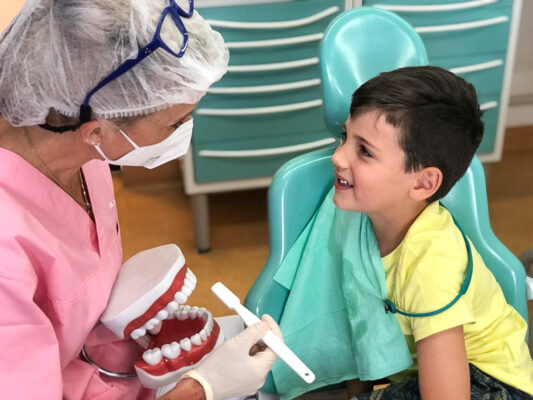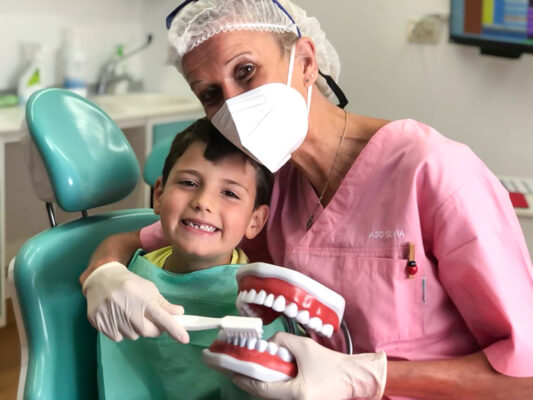Educate on prevenction


Prevention is among the main objectives of children’s dentistry. From the first visit, the children’s dentist, in close collaboration with the dental hygienist, will instruct the little patient and parents on correct home hygiene habits. He will describe the most correct tools to use based on age and moreover he will provide precise dietary instructions so that teeth and gums grow healthily.
Let’s consider that, if oral hygiene is insufficient, cavities, abscesses, periodontal disease or mycosis can also occur in children just like in adults.
The pedodontist also intercepts any bad habits (prolongued use of the pacifier, finger sucking, oral breathing) in close collaboration with the orthodontist. This specialist figure deals with the correction and treatment of occlusal alterations and the management of this bad habits to correctly guide the development of the jaw bones.
The first check-up should be done at the age of 1 and then every 6 or 12 months in order to monitor the oral hygiene, diet and mouth development.
To make your child feel at ease, it would be useful to first take him/her to the clinic just to meet the dentist and become familiar with the orthodontic environment. The second time would be for the real check-up, so that he/she has time to build a faith relationship with the pediatric dentist.
The first baby tooth usually erupts after 6 months and in rare cases earlier (natal teeth if present when the baby is born or neonatal ones if they erupt within the first month) or a few months later.
If the baby is one and the first tooth has not yet erupted, a dental check-up is necessary to verify the development of the baby´s mouth.
Yes, it is. It prevents dental cavities by applying fluorine on formed teeth.
Fluorine is a mineral which facilitates the formation of a more resistant enamel to acid attack of bacterial plaque.
Fluorine should be applied in an accurate way, in order to avoid an overdose which then causes fluorosis, spots and stripes on the tooth surface, or can even collect at skeletal level.
Since fluorine is also present in water and foods like spinach and apples, it is important to verify the amounts taken so that we do not exceed once we decide to take it in drops or tablets.
Tooth remineralisation can be improved by using fluorine toothpastes or mouthwashes to be checked when used by youngest children, thus avoiding ingestion or fluorine excess which can cause opacity of the dental surface.
Ingestion must vary according to age: before the age of 6, it is recommended to use a tooth paste with a low fluorine concentration (>600 ppb), or medium concentration (1000 bbp.) in cases at the risk of cavities. After the age of 6, anterior teeth are less exposed to the risk of opacification and it is therefore possible to use toothpastes with a high fluorine concentration (1500 ppb).
The surface of molar teeth presents deep cracks where food and bacterial plaque collect and cause cavities.
Dental sealants are made of a special white-transparent resin which releases fluorine ions and close natural cracks, protecting teeth in a rapid and painless way.
Since not all cracks are at the risk of cavities, your dentist will be the one to tell you if it is necessary or not to seal your child´s teeth.
This operation is usually done on permanent teeth which have just erupted and does not require anesthetics nor the use of a drill. The child will not feel any difference when chewing.
Dental sealings last many years but need to be kept under control to avoid the formation of cavities.
Intercept the predisposition to the develop a tooth decay is never too early. Thanks to this test investigation, which lasts a maximum of 30 minutes, we promptly intercept patients who may have a greater propensity to develop a carious disease. The causes can be different, from a patient’s predisposition to incorrect eating or hygiene habits.
Read the articol to find out more on this test (ITALIAN LANGUAGE)
How to take care of baby teeth (or deciduous teeth)
Taking care of baby teeth is extremely important since their preservation allows to create the right spaces to host permanent teeth and avoid orthodontic problems.
Baby teeth are important not only to chew correctly, but also because they are involved in the jaw and lower jaw growth, in the future and correct eruption of permanent teeth and they allow the child to correctly develop speech and phonology.
Cavities of baby teeth should not be ignored because they can cause infections not only inside the mouth, but in the whole body.
Cavities are mainly caused by wrong food habits such as sweet drinks taken through baby bottles or pacifiers dipped in sweet substances, used to calm down children.
Cavities appear like small demineralisations close to the gum of upper incisors, which can then cause small cavities and develop into bigger wounds and damage baby molars.
The care of a baby tooth is similar to the one of a permanent one, but we should keep in mind that a younger patient needs more attention and a more relaxed environment that make him/her feel at ease.
Starting from the age of 6, the first permanent teeth appear in the child’s mouth. Just like for adults, these teeth may require treatment of carious processes through simple or complex fillings or root canal treatment.
In some cases, perhaps at the end of an orthodontic treatment, it is possible to intervene with a Coronoplasty in order to modify the shape of the teeth using a composite material applied to the natural teeth for closing the spaces between one tooth and another (e.g.: diastema between the central incisors).
Traumas can cause teeth to break or come out of their natural position and even the fracture of structures supporting them. If this is the case, we advice you to go to the nearest hospital. If the trauma is violent, you should contact both your pediatrician and orthodontist, so that they can consider the trauma´s consequences on the child´s growth.
If a permanent tooth comes out of its position, we can try to save the ligament´s fibers which, otherwise, die very rapidly. In this case, we proceed with an immediate reimplant which means manually inserting the tooth in its natural position.
Before doing this, we need to clean the wound and remove possible remains which can cause infections and carefully rinse the tooth with lukewarm water, without ever touching the root and the delicate fibers.
After the reinsertion, it is important to immediately go to the dental office where the tooth will be anchored to neighboring teeth in order to resettle.
If we want the dentist to reinsert the tooth, we need to dip it in a physiological solution or in milk, in order to maintain hydration and avoid the root fibers to die during their rapid transport to the dental office.
Its conservation in a physiological solution or milk is necessary if a tooth fragment breaks.
If the trauma involves baby teeth, they cannot be reinserted since it would damage the gem of the permanent tooth already present underneath the baby one.
In these cases, we can apply a sterile gauze to contain the bleeding and ice to kill the pain.
If a baby tooth with exposed pulp breaks, the pedodontist will depulp the tooth by keeping it in its position until its natural substitution. This will enable it to create the necessary space for the permanent tooth.
Read the article dedicated to Dental Accidents

Doc Leo is the messy and funny helper who works together with our doctors and teaches children how to brush their teeth, who are the friends and the enemies of an healthy smile, and that they can forget the feeling of fear in the dentist room.
His tools are: sympathy, a booklet to color and read, a crown and a medal that reward courage, his balloons and colored bracelets.